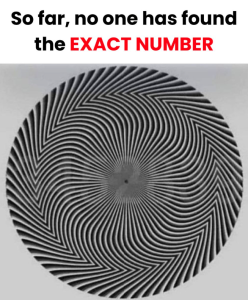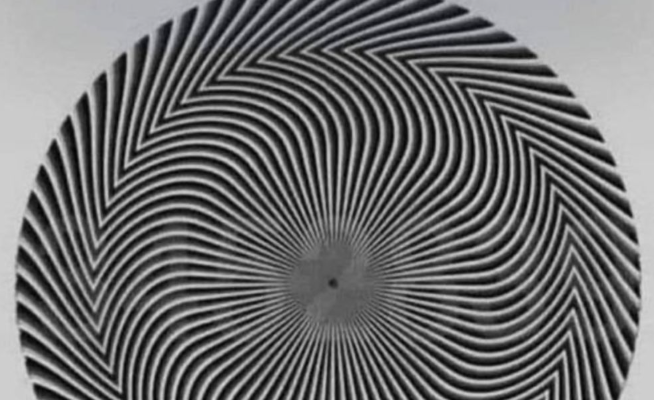
A Number Is Hidden In This Optical Illusion — And Not Everyone Notices It The Same Way
Optical illusions have fascinated humans for centuries, playing tricks on our perception and revealing the intricate ways our brains process visual information. One particularly intriguing category of illusions involves hidden numbers, images that seem like ordinary patterns or designs at first glance, but contain a numeric figure that some people spot immediately while others struggle to see it at all. These illusions are not just fun puzzles—they also reveal a lot about attention, perception, and cognitive differences among individuals.
Imagine being presented with an image of swirling black-and-white lines or seemingly random shapes, and then being told that a number is hidden somewhere within. Some people can identify it in seconds, while others stare at the pattern for minutes, seeing nothing at all. This variation in perception is what makes hidden number illusions so captivating.
The Science Behind Hidden Numbers
At the core of hidden number illusions is the principle of figure-ground perception, a concept in cognitive psychology. Essentially, your brain is constantly trying to distinguish an object (the “figure”) from its surrounding environment (the “ground”). When a number is camouflaged cleverly within a pattern, your brain must work harder to isolate the figure from the background.
Some hidden number illusions also exploit contrast, shading, and spacing to obscure the number. For instance, the number may be outlined using shapes that are slightly lighter or darker than the surrounding area, or it might be formed by the gaps between lines. The human eye is naturally drawn to high-contrast areas, so the number becomes more noticeable to those whose attention is immediately captured by subtle differences in light or color.
Another factor is pattern recognition skills. People who are good at identifying shapes and sequences, or who have a strong visual-spatial ability, tend to spot hidden numbers more quickly. Conversely, those who focus on the overall pattern rather than individual elements may miss the number entirely at first glance.
Why People See Numbers Differently
One of the most fascinating aspects of hidden number illusions is that everyone sees them differently. Here are some reasons why:
-
Focus of Attention: Some viewers immediately focus on edges or contrast, while others scan the image more globally. This difference in scanning patterns can determine whether someone spots the number quickly or not.
-
Experience With Puzzles: Individuals who frequently engage in puzzles, crosswords, or visual games are often more adept at noticing subtle differences in patterns. Their brains are trained to look for anomalies that may indicate hidden elements.
-
Expectations and Suggestion: If someone is told a number is hidden in an image, they are more likely to search actively for it. Without this suggestion, some people may look at the pattern passively and miss it entirely.
-
Individual Perception Differences: Neurological factors, such as how the brain processes visual signals, play a role. Some people have heightened visual discrimination, allowing them to separate objects from a complex background more easily. Others may have difficulty filtering out distracting visual information.
Because of these variables, two people can look at the same hidden number illusion and have completely different experiences. One might exclaim, “I see it immediately!” while the other struggles for several minutes, only spotting the number after hints or guidance.
Famous Examples of Hidden Number Illusions
Hidden numbers aren’t a new phenomenon. They have appeared in various forms in art, advertising, and psychology experiments:
-
Dalí and Surrealist Art: Salvador Dalí and other surrealist artists sometimes incorporated hidden numbers and symbols in their work, challenging viewers to look beyond the obvious.
-
Camouflaged Puzzles: Some visual puzzles deliberately hide numbers within dense patterns or textures, often using lines, dots, or swirls to obscure the shape. These puzzles are popular in brain-training books and educational materials.
-
Magic Eye-Style Illusions: While most people associate Magic Eye images with 3D figures, some variations hide numbers that can only be seen when focusing correctly or shifting visual perspective.
These examples demonstrate that hidden numbers aren’t just about entertainment—they’re also used to train observation, enhance cognitive flexibility, and challenge perception.
How to Improve Your Ability to Spot Hidden Numbers
If you struggle with these illusions, don’t worry—you can improve your visual perception skills. Here are some tips:
-
Slow Down: Don’t rush. Hidden numbers are often subtle, and taking your time allows your brain to process fine details.
-
Change Your Focus: Instead of staring at the image as a whole, examine small sections individually. Look at edges, corners, and areas of contrast.
-
Tilt Your Head or Change Distance: Some numbers become clearer when you view the image from a slightly different angle or distance. Our brains sometimes perceive shapes differently depending on perspective.
-
Practice Regularly: Regularly engaging in visual puzzles and optical illusions can enhance your brain’s pattern recognition and attention to detail.
By practicing these strategies, many people find they can spot hidden numbers more quickly and enjoy the “aha!” moment that comes with discovery.
What This Illusion Teaches Us
Beyond the entertainment factor, hidden number illusions teach us important lessons about human perception and cognition:
-
Perception is Subjective: Everyone interprets visual information differently, and no single viewpoint is “wrong.”
-
Attention Matters: The way we focus our attention greatly influences what we notice. Mindful observation can uncover hidden details in everyday life, not just in puzzles.
-
Patience is Valuable: Rushing can cause you to miss important details. Hidden number illusions reward patience and careful analysis.
-
The Brain is Powerful: Even when a number is camouflaged perfectly, our brains can adapt and learn to see it. This demonstrates our capacity for growth and learning.
In other words, hidden number illusions aren’t just visual tricks—they’re small lessons in perception, cognition, and patience.
Conclusion
Next time you see a hidden number illusion, remember that it’s normal to see the number immediately—or not at all. Whether you spot it instantly or take a while, the experience highlights the incredible complexity of human perception. Some people rely on sharp focus and high contrast, others on pattern recognition or experience with visual puzzles, and some simply need the suggestion that a number is present.
These illusions remind us that perception is as much about the observer as the object observed. They encourage curiosity, patience, and a playful approach to challenges. And perhaps most importantly, they show that even in something as simple as an image, the mind is capable of astonishing feats of interpretation and discovery.
So, the next time you stare at an optical illusion hiding a number, take a deep breath, explore slowly, and enjoy the journey. Because in the end, finding the number is not just about seeing—it’s about understanding how your mind interacts with the world around you

